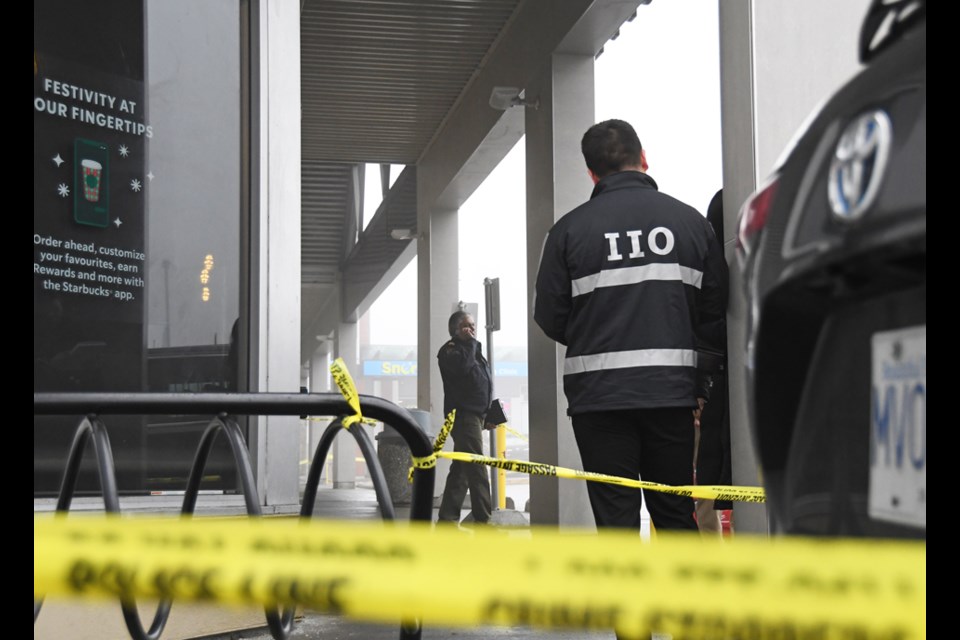B.C.'s police watchdog is not recommending charges in the death of a man during a police incident at a Burnaby Starbucks last year.
The deadly incident unfolded at the Starbucks in Kensington Plaza at 6500 Hastings St. at about 5:30 a.m., according to a report released by the Independent Investigations Office Tuesday.
The report lays out a narrative based on witness testimony and Starbucks security video.
A civilian witness told IIO investigators a man walked into the Starbucks and sat at a table.
She said the man had had sweat running down his face and a bit of dried blood coming from his nose.
He asked her to call the police, but she thought he was overdosing and needed medical attention, so she called an ambulance, according to the report.
When she came back, the man suddenly grabbed her hand, saying repeatedly that he was "so scared," the report said.
The man appeared "paranoid and delusional," according to witnesses, and at one point, after police arrived, he pulled the woman towards the exit door.
Taser deployed
An officer drew out her Taser and warned him she would Tase him if he didn't let the woman go.
The man yelled and walked around pulling the witness between himself and police.
He then released his grip on the woman, who went to a back room where the rest of the staff were sheltering.
The officer deployed the Taser, but it was unsuccessful because one of the two probes failed to make contact.
Despite attempts by officers to take hold of him, the man then walked toward the back room.
The woman whose hand the man had grabbed pulled a refrigerator unit out to block his path, and the refrigerator blocked the view of the CCTV camera in that area, so what happened next was not captured on video.
Medical distress
Witnesses told the IIO the man went down on one knee and then lay down on his right side, according to the report.
Officers handcuffed him and told him he was being apprehended under the Mental Health Act.
"None of the witnesses to (the man"s) apprehension described any improper actions or use of excessive force by any of the involved officers, who were described in various ways as trying to de-escalate the situation, to calm and reassure (the man) and to get him under control as he resisted them," the report states.
By 6:30 a.m., the man was handcuffed and in custody.
He was placed in the recovery position, and, after initially kicking and resisting, calmed down.
He was then lifted into a seated position, resting against the wall, but the officers quickly became concerned because he appeared to fall asleep.
It soon became clear he was in medical distress, and paramedics who arrived at the scene started CPR.
Life-saving efforts continued until 7:31 a.m., when the man was declared deceased.
'Very healthy scepticism'
The paramedics who attended told the IIO they had noted no visible injuries other than marks on the man's wrists from the handcuffs.
The autopsy report noted the presence of some bruising, but no external injury that could have caused or contributed to the man's death.
Toxicology testing revealed recent alcohol and cocaine consumption.
The cause of death was stated as "complications of police altercation in the setting of excited delirium, cocaine use, alcohol use with cirrhosis, obesity, hypertensive and atherosclerotic cardiovascular disease and undefined psychosis."
Chief Civilian Director Ron MacDonald said the IIO maintains a "very healthy scepticism" regarding the finding of "excited delirium" in police-involved sudden death cases since many medical authorities have come to reject the diagnosis as baseless.
"Having said that, the medical evidence that is uncontroversial here is sufficient to establish that it was the stress of the incident, combined with (the man's) very significant pre-existing conditions, that led to his unfortunate death."
MacDonald said the matter would not be referred to Crown counsel for consideration of charges because there were no reasonable grounds to believe any of the officers involved may have committed an offence.
He said all the officers involved were acting in lawful execution of their duty, including the officer who attempted to Taser the man.
"His actions in taking hold of (the witness) and maintaining that hold for a significant time was in itself demonstrative that he posed a potential risk to others, and that he needed to be brought under control," MacDonald wrote.
The evidence collected and analyzed during the IIO investigation included the following, according to the report:
- statements of five civilian witnesses, six first responders and nine witness police officers
- police Computer-Aided Dispatch (‘CAD’) and Police Records Information Management Environment (‘PRIME’) records;
- audio recordings of 911 and radio calls;
- security camera video recordings from the Starbucks premises;
- scene examination and evidence recovery;
- CEW (conducted electrical weapon) examination and analysis;
- Emergency Health Services and Burnaby Fire Department records
- autopsy report, including pathologist’s report and toxicology results.
Follow Cornelia Naylor on Twitter @CorNaylor
Email [email protected]



